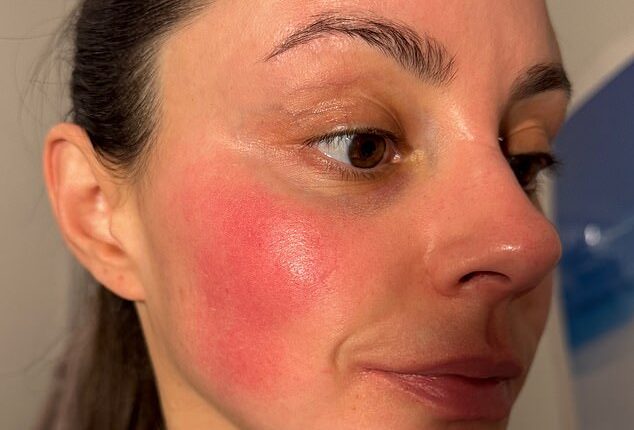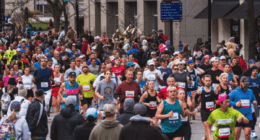‘Wow, you’re so red. Are you OK?’ If you have rosacea, you hear this a lot. And frankly, it grates.
More than just blushing, rosacea, according to consultant dermatologist Dr Ophelia Veraitch, is ‘a chronic inflammatory disorder of the skin’. It affects an estimated one in ten adults in the UK, and women between the ages of 30 to 60 are more prone to it.
The condition usually shows as persistent redness around the cheeks, nose and chin and, in many cases, as small acne-like bumps or pustules. Sadly, rosacea is incurable and it’s one of those skin conditions we actually know very little about.
‘The exact cause of rosacea isn’t fully understood,’ explains consultant dermatologist and founder of Joonbyrd, Dr Alexis Granite. ‘Several factors are thought to play a role, including genetics, heightened inflammatory responses in the skin, increased blood-vessel reactivity and sensitivity to micro-organisms found naturally on the skin.’
In my case, I developed rosacea aged 30. The first time I noticed it was looking in the mirror while applying my makeup. My red cheeks were poking out from under my foundation, but I figured I’d simply missed an area of my face and I was just a little too warm.
A few months later, an appointment with a dermatologist I’d met through work diagnosed me with erythematotelangiectatic rosacea, a sub-type that presents as facial redness, visible blood vessels and flushing.
Now 33, my experience has been a painful one – both physically and emotionally. Perpetually ruddy-faced, with a list of triggers a mile long, I’ve spent the last three years searching for a treatment that works.
Anyone who has rosacea quickly learns that some of life’s best bits – including booze, spicy food, heatwaves and sunshine – can trigger a flare-up, as can stress, exercise and changes in hormone levels.

Emma shows off a patch of rosacea on her cheek before the treatment
‘Hormonal fluctuations during perimenopause and menopause can make rosacea symptoms a lot worse,’ says Dr Granite. ‘Hot flushes and night sweats which cause repeated facial flushing exacerbate vascular reactivity and can also trigger rosacea flares.’
This is why some women notice the onset or worsening of the condition during this time.
As for me, I started by stripping back my lengthy skincare routine as too many products with active ingredients can make things worse. I instead focused on a pared-back regime of gentle, soothing formulas and targeted products found in my local Boots.
‘Over the counter skincare ingredients such as azelaic acid, vitamin C and vitamin E can help calm inflammation and support the skin barrier,’ says Dr Veraitch. ‘But, unfortunately, very few of these products are truly effective for rosacea.’
Avoiding harsh skincare products such as scrubs, acids and retinoids while incorporating calming ingredients is key, but for many, myself included, this isn’t enough to see a change.
However, with a diagnosis – and prescription – from a healthcare professional, your treatment options expand.
‘Oral medications prescribed by a doctor such as low-dose Roaccutane, antibiotics, or topical ivermectin/metronidazole can be very effective,’ adds Dr Veraitch.
Two years ago, with the help of dermatologist Dr Emma Craythorne, founder of Klira, I settled on a cocktail of prescription creams at a cost of £140.99 a month – 15 per cent azelaic acid (sold under the brand names Finacea/Skinoren) to soothe inflammation and kill bacteria, plus 1 per cent ivermectin (branded Soolantra) – and noticed my red cheeks becoming considerably less sore.
If you own horses, cattle, pigs or sheep, you’ve probably heard of ivermectin. The drug is commonly used in veterinary medicine to treat a range of parasites in animals. And it’s no different for us. As humans, a natural part of healthy skin is the community of micro-organisms that live on it. Creepy-crawlies known as Demodex mites which live inside your pores should, indeed must, be on the skin for it to function properly.
Feeding on dead cells, these microbes act as a cleaning system for the skin and, while harmless in those who are healthy, rosacea sufferers have been found to have up to 18 times more of them – suggesting these little critters play a vital role.
In theory, cutting the number of mites could help ease rosacea symptoms. ‘Vascular lasers, intense pulsed light and broadband light are all extremely helpful in treating visible blood vessels and persistent redness,’ says Dr Granite. These treatments work by targeting visible blood vessels with a specific wavelength of light that is absorbed by the red pigment in the blood’s haemoglobin. The light then converts to heat which damages the blood vessel’s walls, causing them to be absorbed by the body.
People with rosacea tend to have more visible blood vessels because the condition causes chronic inflammation and dilation of the tiny blood vessels in the face, which leads to persistent redness.

Emma following her course of Seriderm’s DermaV laser, carried out by consultant dermatologist Dr Ellie Rashid at OneWelbeck Clinic in London
An expert can help determine which option is right for you. In my case, it was a course of Seriderm’s DermaV laser (from £245 a session, with three to four sessions every four to six weeks recommended), with consultant dermatologist Dr Ellie Rashid at OneWelbeck Clinic in London.
This vascular laser targets and breaks down broken blood vessels in the skin, which are then naturally eliminated.
Reclining on Dr Rashid’s treatment table and psyching myself up for a ‘suffer pain for beauty’ moment, I was pleasantly surprised with how relatively comfortable the DermaV was. I’d describe it as like small areas of your face being hit with a jet of crushed ice – not pleasant, but not particularly painful. Downtime was minimal, too – just some slight redness which disappeared within five hours.
‘It’s my favourite laser for rosacea,’ says Dr Rashid. ‘Often you only need a couple of treatments.’
Although it’s not a permanent solution as the blood vessels will return due to pressure from deeper in the skin, the DermaV does a great job of clearing redness for a couple of years, and I noticed a visible difference the next day.
After that, my redness continued to improve. By week three, my skin felt so much better with my usual bright red cheeks looking far more even.
It’s not cheap, but if redness is a concern it is definitely an option worth exploring.
Rosacea is stubborn and treatments can be hit and miss. It took a combination of soothing skincare, doctor-prescribed medications, lasers and a lot of patience but, after two years, my rosacea no longer has me hiding behind makeup.
Red-faced and fed up? I’ve been there. But trust me, there’s hope.









